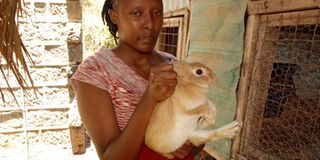Step aside men, women too can breed rabbits

Rahab Wanjiru with one of the rabbits she keeps in Nakuru. PHOTO | SULEIMAN MBATIAH |
What you need to know:
- Rahab Wanjiru rears 100 of them under the business name Rajiwa Rabbits.
- The farmer slaughters rabbits herself and sells the meat at a butchery in Free Area trading centre at Sh500 a kilo.
It is easy to mistake the young woman carrying a hand brush and a bucket of water for a farmhand as she walks in her father’s farm in Maili Sita, Nakuru.
Rahab Wanjiru stops at a rabbit cage. She opens the door, pours in water and starts to scrub the floor.
When she is done with one cage, she moves to the next which takes her about 15 minutes.
“I clean the eight cages every week to ensure my rabbits are free of diseases,” explains Wanjiru.
She rears 100 of them under the business name Rajiwa Rabbits.
“I started four years ago with two rabbits. I bought them at Sh1,000 each and used Sh25,000 to build the cages. I saw there was growing demand for rabbits and decided to try my luck,” says the farmer, who constructed the cages using offcuts and wire mesh with the help of a carpenter specifically trained by Kenya Agricultural Productivity and Agribusiness Programme.
The cages are raised one-and-half metres above the ground to keep the rabbits safe.
“Some ants attacked my rabbits and killed 10 of them when I was starting. I also lost five kits soon after they were born and this was because I did not have good cages.”
Wanjiru keeps various rabbit breeds that include New Zealand and California, which she sells to farmers at between Sh700 and Sh1,000. She sells up to 10 rabbits in a good month.
The farmer slaughters other rabbits herself and sells the meat at a butchery in Free Area trading centre at Sh500 a kilo.
“The butchery is owned by a group of farmers who were brought together under the umbrella of Kenya Agricultural Productivity and Agribusiness Programme through the Ministry of Agriculture and the World Bank. The meat is inspected by health officials at a cost of Sh100 per rabbit before it is sold to consumers.”
She feeds the rabbits on hay, sukuma wiki (collard green), carrots and watermelon leaves.
BIGGEST CHALLENGE
Her biggest challenge is diseases and lack of proper feeds. However, joining the agribusiness has enabled her learn skills to take care of the animals.
She advises women not to fear engaging in any agribusiness, but they must first do research. Rabbit farming is cost-effective and is not labour intensive.
“The industry is on the rise and the future looks bright. Women should not fear to keep rabbits.”
According to Nakuru County Rabbit Value Addition Group chairman Moses Gathua, farmers are trained on how to keep the animals, slaughter, market and add value.
Farmers also learn how to construct cages, coordinate exchange visits with other rabbit farmers, feeding methods, disease detection such as pneumonia and how to deworm them.
“I have also been taught how to comb rabbit fur, keep records and seek market,” says Wanjiru.





